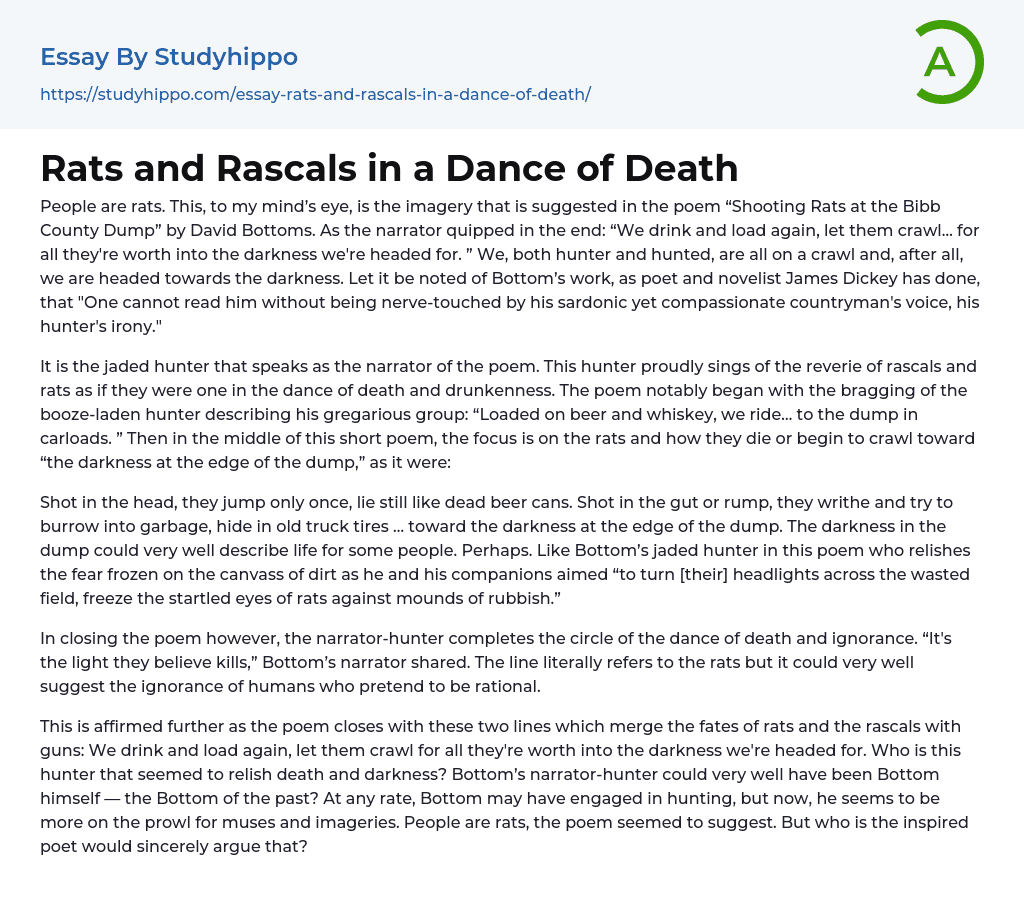The poem "Shooting Rats at the Bibb County Dump" by David Bottoms suggests that people are like rats. The narrator comments that we all crawl towards the darkness and the poem ends with the statement that we drink and load again, allowing the rats to crawl into the darkness. Both the hunters and the hunted are on this crawl. It is worth noting, as poet and novelist James Dickey pointed out, that Bottoms' work carries a sardonic yet compassionate voice of a countryman and a hunter's irony.
The narrator of the poem is a tired and experienced hunter who proudly sings of the reckless and intoxicated rascals and rats, seeing them as one in their dance of death and drunkenness. The poem starts with the boastful words of the hunter, who is heavily influenced b
...y alcohol, describing his sociable group: "We ride to the dump in carloads, loaded on beer and whiskey." As the poem progresses, the attention shifts to the rats and their fate as they perish or move towards "the darkness at the edge of the dump."
They leap in the air only once when shot in the head, and then remain motionless like discarded beer cans. On the other hand, when shot in the abdomen or buttocks, they squirm and attempt to bury themselves in garbage, seeking refuge within old truck tires... heading towards the darkness that lies at the outskirts of the landfill. This darkness in the landfill might symbolize existence for certain individuals. Maybe. Similarly to Bottom's disillusioned hunter in this poem, who takes pleasure in the fear that is frozen in the dirt landscape as
he and his companions aim to illuminate the wasted field with their car headlights, causing the eyes of startled rats to freeze against heaps of rubbish.
The narrator-hunter concludes the poem by completing the cycle of the dance of death and ignorance. Bottom’s narrator believes that "It's the light they believe kills," which could refer to the rats or the ignorance of humans pretending to be rational.
In conclusion, the poem ends with two lines that merge the fate of rats and rascals with guns, emphasizing their connection. The identity of the hunter who delights in death and darkness remains ambiguous. It is possible that Bottom, the narrator-hunter, is also Bottom himself from the past. However, his focus seems to have shifted towards the pursuit of muses and imagery rather than hunting. The poem implies that people are like rats. Yet, who could argue that a genuine poet would hold this belief?
- Book Summary essays
- Metaphor essays
- Reader essays
- Rhyme essays
- Literary devices essays
- Villain essays
- Books essays
- Genre essays
- Literary Criticism essays
- Writer essays
- Protagonist essays
- Simile essays
- Poem essays
- Book Report essays
- Book Review essays
- Greek Mythology essays
- Plot essays
- Tragic Hero essays
- Coming of Age essays
- Play essays
- Rhetoric essays
- Rhetorical Question essays
- Translation essays
- Understanding essays
- Reason essays
- Character essays
- Letter essays
- American Literature essays
- Literature Review essays
- Utopia essays
- Poetry Analysis essays
- Dante's Inferno essays
- Between The World and Me essays
- Incidents in The Life of a Slave Girl essays
- Flowers for Algernon essays
- Myth essays
- Everyday Use essays
- Boo Radley essays
- Genesis essays
- Richard iii essays
- Alice in Wonderland essays
- On the road essays
- Ozymandias essays
- The Nightingale essays
- Holden Caulfield essays
- Animal Farm essays
- 1984 essays
- A Hanging essays
- Shooting An Elephant essays
- A Tale Of Two Cities essays




